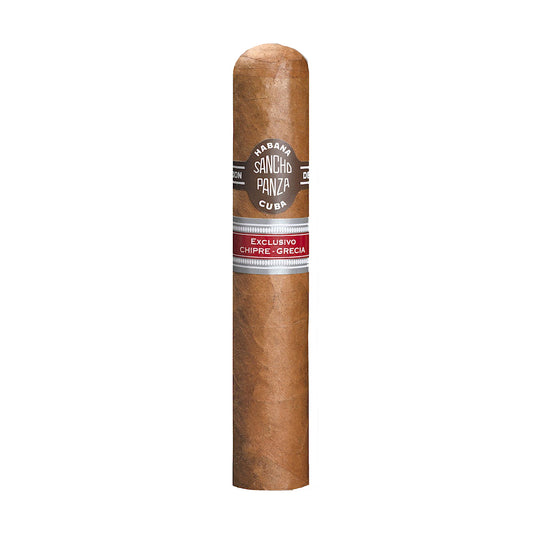
Filter
Sancho Panza Cigars
There is a strong tradition of Cuban cigars being named after heroes of classical literature, and Sancho Panza cigars are a prime example. In 1848 this brand was established in Havana – making it one of the oldest still in production – and adopted the mantle of Don Quixote de La Mancha’s famous companion. An image of the humble farmer who accompanied Don Quixote on his adventures still graces the boxes of Sancho Panza today, flanked on either side by artistic renderings of some of his escapades. Perhaps the idea of an everyday character providing logic and reason in the face of his employer’s growing insanity resonated particularly...READ MORE
Sancho Panza Cigars
There is a strong tradition of Cuban cigars being named after heroes of classical literature, and Sancho Panza cigars are a prime example. In 1848 this brand was established in Havana – making it one of the oldest still in production – and adopted the mantle of Don Quixote de La Mancha’s famous companion. An image of the humble farmer who accompanied Don Quixote on his adventures still graces the boxes of Sancho Panza today, flanked on either side by artistic renderings of some of his escapades. Perhaps the idea of an everyday character providing logic and reason in the face of his employer’s growing insanity resonated particularly closely with the working-class torcedores of the mid-19th century, leading to them choosing his name for the brand - whatever the reason, the reference is still a popular one, almost 200 years hence.
Like so many Habanos brands of a similar age, much of the history of Sancho Panza cigars is lost to the mists of time. What we do know is that in 1848, from a factory at 48 Angeles Street in Havana, a gentleman by the name of Don Emilio Ohmstead registered a new brand and began producing cigars. His initial efforts were not too well rewarded, and by the end of the century (some time around 1898) the company had closed down. Something about the name must have continued to hold the affection of some important figures in the cigar world, however, for just a few years later the brand was re-introduced under the stewardship of Ramon Allones, before being sold to the Rey del Mundo company around 1940. It was in this period that the popularity of Sancho Panza cigars saw a marked increase – especially in the Spanish market, no doubt a reaction to the use of arguably their greatest literary export for the name – and the presence of the brand was properly established. Like all other producers, the marca was nationalised in 1960 by the new revolutionary government.
Today’s line-up of Sancho Panza cigars is almost unrecognisable from the original – from a peak of 13, as of 2022 there is only one vitola in regular production. Today only the Sancho Panza Belicosos – a statuesque piramides, 5 ½ inches long by 52 ring gauge which will provide around 60 minutes of sweet, woody flavours – is continuously made, although reports from Havana do state that the Sancho Panza Non Plus – a classic Mareva vitola at 42 ring gauge by 5 ⅛ inches, providing cedar, nut and earth flavours for around 35 minutes – are still in production despite having been officially discontinued in 2019. Every so often the brand, with its medium-strength blend and understated brown bands, is selected for Regional Edition cigars, with the Sancho Panza Gran Quixote the most recent example. Smokers of Belgium and Luxembourg were treated to only 10,000 boxes of these magnificent double-perfectos, which borrowed their shape from a Cuaba cigar. At 6 ⅜ inches by 52 ring gauge (at its thickest point) this stick provides dark-roast coffee notes for well over an hour.
The slimming down of a Cuban marca’s portfolio is not uncommon, the process having been applied to all brands at some point or another. To have the offering reduced to just one cigar, however, is unusual, and has robbed aficionados of some wonderful sticks. Probably most sorely-missed from Sancho Panza is the Molina, named for the windmills at which Don Quixote himself so famously tilted at, but this is far from being the only cigar which smokers are forced to reminisce about and lament the demise of. Remaining examples are now highly prized on the collector’s market.
Sancho Panza himself was a key figure in Cervantes’ novel Don Quixote, a book which is still often named as the greatest novel of all time. While the title character is famed for his idealism and wild fantasist existence, Sancho Panza is his proudly illiterate and down-to-earth companion. Where Don Quixote offers a rose-tinted perspective of chivalry and knighthood and the conduct of society according to an ancient code of honour, Sancho Panza serves to remind him how the realities of life for the majority are far removed from his master’s world, delivering wisdoms held by the people and earned as a result of a life of hard work. He rides a donkey, as opposed to a proud steed, and his common sense is often the saviour of his unpredictable leader. It is easy to see why such a character captured the imagination of the Cuban people of the 1840s, and why they chose his name and image for this cigar brand.
Today Sancho Panza cigars are not among the most popular brands in the Habanos pantheon, nor are they often found in physical retail premises where space is at a premium. They are, however, a proud and valuable link to the golden age of Havana’s cigar production, and a brand well worth investigation by those who wish to expand their cigar knowledge.
Brand Founded: 1848
Strength: Medium
Construction: Handmade, Tripa Larga
Continuous Production Cigars: 1















